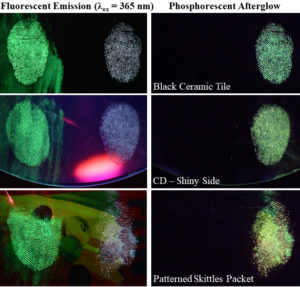Griffith University researchers have identified a new phosphorescence fingerprinting technique that reveals previously hidden details in fingerprints, helping in the fight against crime.
Dr William Gee from the Queensland Micro and Nanotechnology Centre found that imaging the phosphorescent afterglow from a newly developed environmentally-friendly fingerprint powder outperformed traditional commercial fluorescent powder by eliminating background interference.

Dr William Gee from the Queensland Micro and Nanotechnology Centre
“Our work developed an improved fingerprint powder by exploiting visible and longer-lived phosphorescent light,” Dr Gee said.
“Current fingerprint powders emit short-lived fluorescence that needs constant illumination with a powerful light for the fingerprint to be visible.
“Constantly shining a bright light to trigger fluorescence can swamp the weaker emissions, obliging the use of filters to view the fluorescence and goggles to protect sensitive eyes.”
These factors can lower the quality of fingerprint images and some challenging surfaces can produce their own fluorescence under these conditions, which interferes with fluorescent fingerprint powders.
“We showcased our phosphorescent fingerprint powder on challenging surfaces with inbuilt fluorescent security features, such as passports and banknotes, and found that it outperformed a commercial fluorescent fingerprint powder.”

Comparison of fingerprinting techniques on a ceramic tile, CD, and skittle packet
Previous efforts to utilise visible phosphorescence have required impractical imaging equipment and powerful laser setups, both of which are beyond the scope of typical forensic laboratories.
“Our work overcomes these drawbacks by eliminating the need for specialist scientific equipment to capture the phosphorescent afterglow image.
“Our phosphorescent technique just needs a commercial digital camera and forensic light sources, equipment that’s readily available as it is routinely used by police and forensic practitioners.”
Dr Gee points out that the 4-tpt phosphorescent powder they have chosen contains no heavy metals, which is beneficial for both safety and environmental reasons.
“From a forensic perspective, metal-containing powders have been implicated in DNA degradation, which hampers the collection of touch DNA evidence from treated fingerprints, which can be crucial in solving a crime.
“This new phosphorescent powder technique for fingerprinting will be of great interest to both laboratory and field-based forensic practitioners/police and has the potential to trigger transformative changes within the fingerprint community.
The research has been published in the journalAnalyst.


